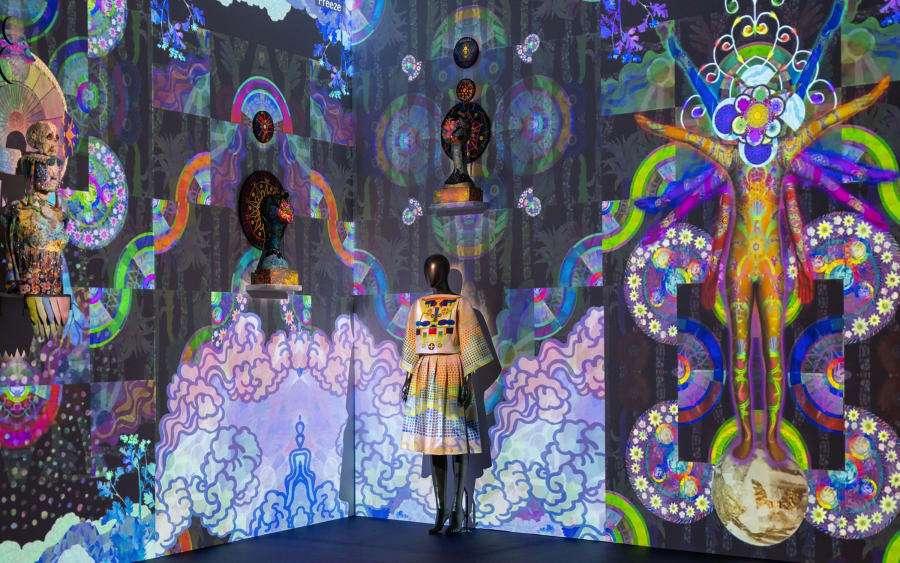Imagine the most beautiful version of yourself. What do you see? How do you feel? What do you look like?
Is your skin glowing with a glassy sheen, hair falling in frictionless sheets as it frames a face so symmetrical it looks to have been airbrushed into existence? Are your lips suggestively offset by a glimmer of gloss? Your nose a delicate, near-invisible axis?
Maybe there’s an alternative. What if, with our endless rainbow of references, we used the technology we have in order to design rather than conform – or, even better, defy? What if, instead of filtering ourselves into nothingness, we took up space in every dimension?
Online, we could approach identity with imagination and reclaim the rituals of beauty. Yet, beauty ideals have never felt so contrived. Social media algorithms surface the same symmetrical faces on an endless loop, legislators argue over what makes a woman, platforms censor body parts. Against this tightening frame, imagination becomes an act of survival.
‘Virtual Beauty’, the exhibition opening at Somerset House this month, steps directly into these tensions, assembling more than 20 artists to archive the algorithmic face while also rewriting its code and asking who gets to program desire in the digital age – and how far those rules will bend.
‘We are all chimeras, theorized, and fabricated hybrids of machine and organism; in short, we are cyborgs,’ Donna Haraway prophesied in 1985. She dreamed of technology as a route to unrestricted, defiant identities. What we got instead was a perfectly contoured dataset: fiction calcified into a diktat. The logic is surgical and algorithmic: nip, upload, like, repeat.
The research for my book Pixel Flesh (2024) followed teenage girls who scroll for hours through faces they can never quite resemble – every refresh spawning another deficit, another chasm between expectation and reality. They are haunted by an omnipresent invisible audience, with girls as young as eight declaring their desire to look ‘filtered’ and ‘perfect’ at all times.
A question central to my work these past few years has been: ‘How do we create a beauty culture that rewards creativity instead of conformity?’ ‘And what might that look like?’ When I put the question to experts across different fields, I was often met with silence. It is far easier to critique than to build, to imagine a different world and bring it to life. So, I turned to creatives – to those daring to dream of an alternate reality and propose the solutions we struggle to name.
Artists exploring beauty in 2025 are pulling technological hybrids back toward Haraway’s sense of mischief, glitch, and multiplicity. They re-imagine grooming rituals as world-building tools, moving from copy-paste homogeny into a space for new, plural aesthetics. While this new wave of practitioners also treat identity as something to curate, they curate it selectively, playfully, critically. Their tools are engines, renders, looms, and pigments, but their real medium is agency.
Some of these artists are coming together in ‘Virtual Beauty’. Co-curated by Gonzalo Herrero Delicado, Mathilde Friis, and Bunny Kinney, the exhibition originated at HEK (House of Electronic Arts) in Basel, Switzerland, last year, and makes its London debut on July 23.
One of the artists in the exhibition is Minne Atairu, who describes herself as ‘a builder.’ ‘I’ve worked with generative AI for years, and I want to create systems a Black woman like myself would actually use,’ she tells me. She is showing her latest work, Da Braidr (2025), a text-to-braid generator that allows users to create custom beauty images of various hairstyles. The images generated by Da Braidr are bold and joyous, with visible pores and skin with an oily sheen. ‘I find that a lot of systems have this very idealized version of what a Black woman might look like – smooth, poreless, perfect hair. I’m not trying to build another Facetune or Photoshop,’ she continues. ‘The representation of Blackness sits within a zone of critique but never really transcends that conversation. How do we start building things that work for our communities, from our perspective?’
Qualeasha Wood wages a parallel war on erasure, weaving webcam selfies, emojis, and desktop debris into jacquard tapestries. ‘I create something in the name of reclamation – of space, beauty, authorship,’ she explains when I ask about her piece on display at Somerset House, It’s All For U (If You Rlly Want It) (2024) – a self-portrait whose Black femme avatar gleams beneath tangled moiré halos. Wood chose the loom for its links to early computing: ‘Online, our images are everywhere and nowhere, copied but not archived. Weaving forces time into them, making a disposable file permanent.’ She calls the work both resistance and desire, a monument to bodies ‘visible only when the world can use them.’
Where Wood slows the scroll to a devotional crawl, Ines Alpha lets ornament appear and evaporate at will. Her multiscreen installation I’d rather be a cyborg (2024) shows the artist drifting inside a glowing capsule as hybrid organisms – part nature, part machine – sprout from her skin. Visitors to the exhibition can summon the same sci-fi adornments in an Augmented Reality mirror. ‘In the digital age, I’ve struggled with my own image, but using 3D software to create new personas has helped me reclaim power over my self-expression and identity,’ she tells me.
Uniting these practices is a refusal to linger in the critical mode that dominated late-20th-century beauty discourse; the center of gravity has shifted from post-Internet autopsy to speculative construction. The Instagram hoaxes of the early 2010s tore at the mirror-screen to reveal its wiring; the cohort of the 2020s builds new mirrors with modifiable innards. They’re invested not only in diagnosing the apparatus but in redirecting its force toward plurality. Atairu captures the pivot neatly: ‘I’m entering this phase where I want to not just critique the system but fix it.’ That shift matters because critique alone cannot compete with the pace of platform aesthetics; only alternative prototypes offer genuine exits.
The artists leading this repositioning share a conviction that building beats lamenting. Atairu says she is ‘improving the system so we can better see ourselves.’ Alpha talks of ‘rewriting the rules of beauty and selfhood.’ Wood frames her tapestries as ‘operating systems’ that process, crash, and update like any other device. All see beauty as infrastructure – flawed, therefore fixable – and are inviting the public to the workshop.
‘When you talk about digital and beauty, there’s a small revolution every day,’ says co-curator Friis. She wants ‘Virtual Beauty’ to feel ‘more egalitarian and democratic’ than any algorithmic feed.
The goal is less a verdict than an engine: a space that deliberately widens the visual bandwidth most algorithms still constrict, reminding us we were never meant to see the same faces surfacing on loop. The show’s breadth – from Frederik Heyman’s embalmed avatars to Anan Fries’s speculative birthing body – invites audiences to test, discard, and rebuild the idea of beauty in real time. Friis hopes the pieces rekindle ‘some of that early-Internet enthusiasm, a space to feel liberated rather than surveilled.’
The current political backdrop sharpens the stakes. Across legislatures and timelines, conservatism bills itself as common sense: narrow silhouettes, legislated pronouns, the promise of safety through uniformity. Against that backdrop comes the eternal question: How will this end? Perhaps it never does. Our goal, then, could be to keep exploring alternatives, guided by pleasure and generosity rather than lack thereof. A generation raised on filters already knows the body can morph; the task now is to ensure that morphing serves curiosity, not coercion.
Our vision of beauty should be pluralistic and fluid, offering versions over verdicts, and committed to nurture in every dimension. Haraway warned that fiction can harden into dogma. Artists in 2025 are answering with pragmatic optimism: keep fiction mobile, keep inscription editable, replace the mandate to perfect with the invitation to configure, reconfigure, abandon, restart. ‘I think that now more than ever, we need to carve out space for people to feel safe in the process of becoming,’ says co-curator Kinney. A beautiful future begins the moment we accept that nothing about the body and mind is assured – except, perhaps, the mind’s capacity to imagine more.
'Virtual Beauty'
23 July–28 September 2025
Somerset House, London
Ellen Atlanta is a UK-based writer and cultural researcher whose work traces the intersection of beauty, feminism, and digital culture. Her critically acclaimed debut book Pixel Flesh: The distortion of the female body in a world obsessed by image – and how we can change it was published in 2024.
Caption for header image: filip custic, pi(x)el, 2022. pi(x)el©filipcustic_Courtesy: Onkaos.
Published on July 22, 2025.


